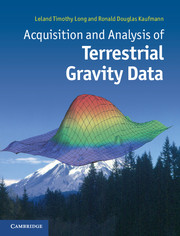Adams, Donald C., and Keller, Randy G., (1996). Precambrian basement geology of the Permian basin region of west Texas and eastern New Mexico: a geophysical perspective, Bulletin of the American Association of Petroleum Geologist, Vol. 80, 410–431.
ASTM Standard, D6430, 1999 (2010), “Standard guide for using the gravity method for subsurface investigation”, ASTM International, West Conshohocken, PA, 2010, DOI: 10.1520/D6430-99R10.
Birch, F., (1961). The velocity of compressional waves in rocks to 10 kilobars. Part 2. Journal of Geophysical Research, Vol. 66(7), 2199–2224
Blakely, Richard J., (1995). Potential Theory in Gravity and Magnetic Applications, New York, Cambridge University Press, New York, p. 441.
Brocher, T. M., (2005). Empirical relations between elastic wavespeeds and density in the Earth's crust, Bulletin of the Seismological Society of America, Vol. 95(6), 2081–2092.
Butler, D. K., (1984). Microgravimetric and gravity gradient techniques for detection of subsurface cavities, doi: 10.1190/1.1441723, Geophysics, Vol. 49(7), 1084–1096.
Cogbill, A. H., (1990). Gravity terrain corrections using digital elevation models. Geophysics, Vol. 55, 102–106.
Cook, Frederick A., Brown, Larry D., Kaufman, Sidney, Oliver, Jack E., and Peterson, Todd A., (1981). COCORP seismic profiling of the Appalachian orogen beneath the coastal Plain of Georgia, Geological Society of America Bulletin, Part 1, Vol. 92, 738–748.
Dobrin, Milton B., (1976). Introduction to Geophysical Prospecting, New York, New York, McGraw-Hill Bock Company, New York, New York, p. 630.
Dorman, L. M., and Lewis, B. T. R., (1970). Experimental isostasy, 1. Theory of the determination of the Earth's isostatic response to a concentrated load, Journal of Geophysical Research, Vol. 75, 3357–3385.
Dorman, L. M., and Lewis, B. T. R., (1972). Experimental isostasy, 3, Inversion of the isostatic Green function and lateral density changes, Journal of Geophysical Research, Vol. 77, 3068–3077.
Fedi, Maurizio, and Pilkington, Mark, (2012). Understanding imaging methods for potential field data, Geophysics Vol. 71(1), G13–G24.
Gardner, G. H. F., Gardner, L. W., and Gregory, A. R., (1974). Formation velocity and density – the diagnostic basics for stratigraphic traps. Geophysics, Vol. 39(6), 770–80.
Hammer, S., (1939). Terrain corrections for gravimeter stations: Geophysics, Vol. 4, 184–194.
Hawman, R. B., (2008). Crustal thickness variations across the Blue Ridge Mountains, Southern Appalachians: An alternative procedure for migrating wide-angle reflection data, Bulletin of the Seismological Society of America Vol. 98(1), 469–475.
Hawman, Robert B., Khalifa, Mohamed O., and Baker, M. Scott, (2011). Isostatic compensation for a portion of the Southern Appalachians: Evidence from a reconnaissance study using wide-angle, three-component seismic soundings. Bulletin of the Seismological Society of America, Vol. 124(3–4), 291–317.
Heiskanen, W. A., and Meinesz, F. A. Vening, (1958). The Earth and its Gravity Field, McGraw-Hill Book Company, p. 364.
Heiskanen, W. A., and Moritz, H., (1967). Physical Geodesy, San Francisco, W. H. Freeman and Company, San Francisco, p. 364.
Heiskanen, Weikko A., and Moritz, Helmut, (1965). Physical Geodesy, San Francisco, W. H. Freeman and Company, San Francisco, p. 364.
Hinze, W. J., Aiken, C., Brozena, J., Coakley, B., Dater, D., Flanagan, G., Forsberg, R., Hildenbrand, T., Keller, G. R., Kellogg, J., Kucks, R., Li, X., Mainville, A., Morin, R., Pilkington, M., Plouff, D., Ravat, D., Roman, D., Urrutia-Fucugauchi, J., V´eronneau, M., Webring, M., and Winester, D., (2005). New standards for reducing gravity data: The North American gravity database, Geophysics, Vol. 70(4), J25–J32.
Kaufmann, R. D., and Long, L. T., (1996). Velocity structure and seismicity of southeastern Tennessee, Journal of Geophysical Research, Vol. 101(B4), 8531–8542.
LaFehr, T. R., (1991). An exact solution for the gravity curvature (Bullard B) correction: Geophysics, Vol. 56, 1179–1184.
Lees, J. M., and VanDecar, J. C., (1991). Seismic tomography constrained by Bouguer gravity anomalies: Applications in Western Washington, PAGEOPH, Vol. 135, 31–52.
Lewis, B. T. R., and Dorman, L. M., (1970). Experimental isostasy, 2, An isostatic model for the U.S.A. derived from gravity and topographic data, Journal of Geophysical Research, Vol. 75, 3367–3386.
Long, L. T., and Liow, Jeih-San, (1986). Crustal thickness, velocity structure, and the isostatic response function in the Southern Appalachians, in Reflection Seismology: The Continental Crust, Geodynamics Series, American Geophysical Union, Vol. 14, 215–222.
MacMillan, W. D., (1958). The Theory of the Potential, New York, Dover, New York, p. 469.
Menke, William, (1984). Geophysical Data Analysis: Discrete Inverse Theory, New York, Academic Press, Inc., New York, p. 260.
Mohr, P. J., Taylor, B. N., and Newell, D. B., (2011). “The 2010 CODATA Recommended Values of the Fundamental Physical Constants” (Web Version 6.0). This database was developed by J. Baker, M. Douma, and S. Kotochigova. Available at [Friday, 22-Jul-2011 10:04:27 EDT]. National Institute of Standards and Technology, Gaithersburg, MD 20899.
Morelli, C., ed., (1974). The International Gravity Standardization Net, 1971, International Association of Geodesy, Special Publication 4.
Moritz, H., (1980). Geodetic Reference System 1980, Journal of Geodesy, Vol. 54, 395–405.
Nafe, J. E., and Drake, C. L., (1963). Physical properties of marine sediments. In The Sea, Vol. 3, ed. Hill, M. N.. New York, Interscience, New York, pp. 794–815.
Nagy, D., (1966). The gravitational attraction of a right rectangular prism, Geophysics, 31, 362–371.
Natonal Geospatial-intelligence Agency, Office of GE OINT Sciences: (2012). Gravity Reference Base Station File History. .
Nettleton, L. L., (1939). Determination of density for reduction of elevation factor. Geophysics, Vol. 4(3), 176–83.
Parks, H. V., and Faller, J. E., (2010). A simple pendulum determination of the gravitational constant, Physical Review Letters, Vol. 105, Issue 11, id. 110801. .
Rothe, George H., and Long, L. T., (1975). Geophysical investigation of a diabase dike swarm in west-central Georgia, Southeastern Geology, 17(2), 67–79.
Stephenson, Randell, and Lambeck, Kurt, (1985). Isostatic response of the lithosphere with in-plane stress: application to central Australia, Journal of Geophysical Research, Vol. 90(B10), 8581–8588.
Talwani, M., and Ewing, M., (1960). Rapid computation of gravitational attraction of three-dimension bodies of arbitrary shape. Geophysics, 25(1), 203–225.
Telford, W. M., Geldart, L. P., and Sheriff, R. E., (1990). Applied Geophysics, 2nd Edition, New York, Cambridge University Press, New York, p. 770, table 6.1 Average densities of common sedimentary rocks.
Watts, A. B., (2001). Isostasy and flexure of the lithosphere, Cambridge, United Kingdom, Cambridge University Press, Cambridge, United Kingdom, 451 pp.





